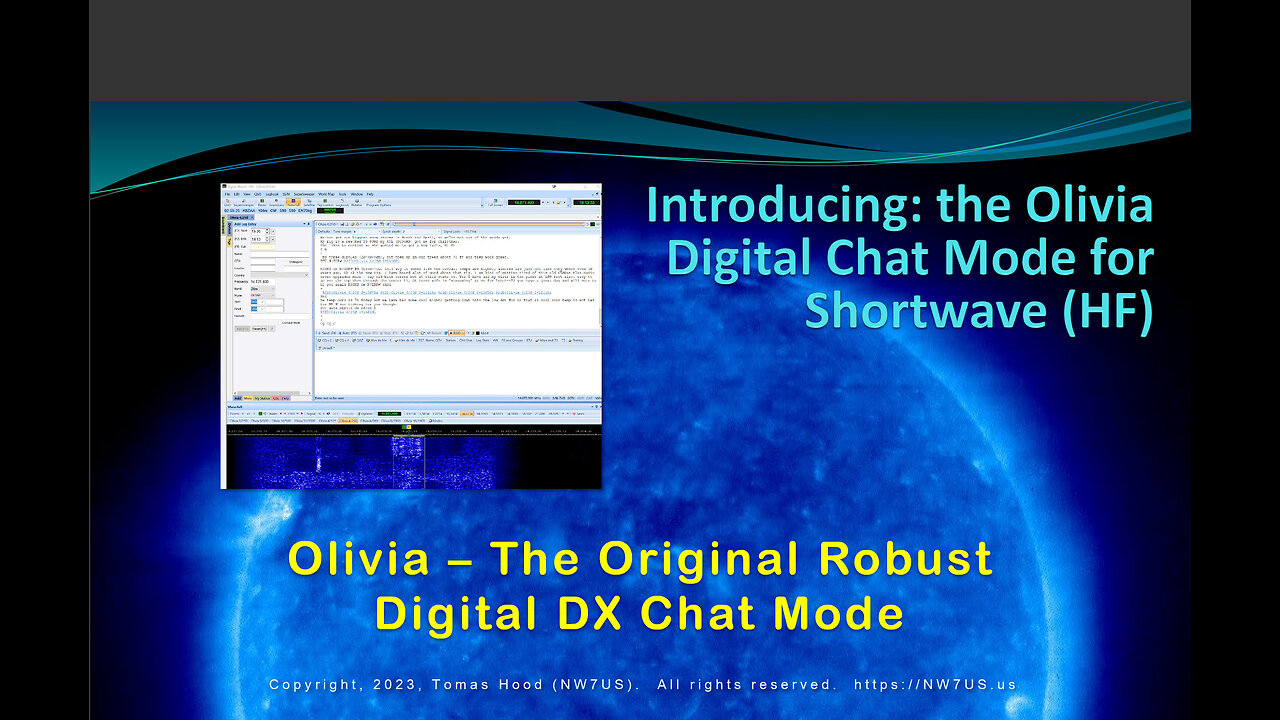Premium Only Content

Introduction to the Olivia Digital Communications Mode (HF, Amateur Radio)
Olivia is the digital communications mode on shortwave (high frequency sub band, or, HF) for amateur radio operators who want more than the "Check Propagation" FT8 mode. This video is an introduction that was presented to the Raleigh Amateur Radio Society ( https://www.rars.org/ ) on December 12, 2023. Presented by Tomas Hood, NW7US
Olivia information can be found, here:
https://OliviaDigitalMode.org
Olivia, a Multi-Frequency Shift Keying (MFSK) radioteletype digital mode, is an amateur radioteletype protocol designed to work in difficult (low signal-to-noise ratio plus multipath) propagation conditions on shortwave radio (i.e., high-frequency, or HF) bands. The typical Olivia signal is decoded when the amplitude of the noise is over ten times that of the digital signal! It is commonly used by amateur radio operators to reliably transmit ASCII characters over noisy channels (slices of high-frequency spectrum -- i.e., frequencies from 3 MHz to 30 MHz; HF) exhibiting significant fading and propagation phasing.
The Olivia digital modes are commonly referred to by the number of tones and the bandwidth used (in Hz). Therefore, it is common to express the Olivia digital mode as Olivia X/Y (or, alternatively, Olivia Y/X ), where X refers to the number of different audio tones transmitted, and Y refers to the bandwidth in Hertz over which these signals are spread. Examples of common Olivia modes are, 8/250 (meaning, 8 tones/250-Hertz bandwidth), 16/500, and, 32/1000.
The protocol was developed at the end of 2003 by Pawel Jalocha. The first on-the-air tests were performed by two radio amateurs, Fred OH/DK4ZC and Les VK2DSG, on the Europe-Australia propagation path in the 20-meter shortwave radio amateur band. The tests proved that the Olivia protocol (or, digital mode) works well and can allow regular intercontinental radio contacts with as little as one-watt RF power (when propagation is highly-favorable). Since 2005, Olivia has become a standard for digital data transfer under white noise, fading and multipath, flutter (polar path) and auroral conditions.
Olivia can perform nearly as good as the very popular WSJT mode, FT8, and better than FT4.
See you on the waterfall!
-
 4:38
4:38
Amateur Ham Radio Shortwave (LF, MF, HF, VHF, UHF, SHF) Communications + Space Weather
4 months agoVoice of Korea International Shortwave Broadcast Station, August 8, 2024
288 -
 11:45:14
11:45:14
Right Side Broadcasting Network
9 days agoLIVE REPLAY: TPUSA's America Fest Conference: Day Three - 12/21/24
231K26 -
 12:19
12:19
Tundra Tactical
6 hours ago $2.69 earnedDaniel Penny Beats Charges in NYC Subway Killing
15.6K4 -
 29:53
29:53
MYLUNCHBREAK CHANNEL PAGE
1 day agoUnder The Necropolis - Pt 1
72.9K42 -
 2:00:10
2:00:10
Bare Knuckle Fighting Championship
3 days agoCountdown to BKFC on DAZN HOLLYWOOD & FREE LIVE FIGHTS!
36K3 -
 2:53:01
2:53:01
Jewels Jones Live ®
1 day agoA MAGA-NIFICENT YEAR | A Political Rendezvous - Ep. 103
71.4K22 -
 29:54
29:54
Michael Franzese
10 hours agoCan Trump accomplish everything he promised? Piers Morgan Article Breakdown
87.6K48 -
 2:08:19
2:08:19
Tactical Advisor
14 hours agoThe Vault Room Podcast 006 | Farwell 2024 New Plans for 2025
166K11 -
 34:12
34:12
inspirePlay
1 day ago $4.94 earned🏆 The Grid Championship 2024 – Cass Meyer vs. Kelly Rudney | Epic Battle for Long Drive Glory!
71K8 -
 17:50
17:50
BlackDiamondGunsandGear
11 hours ago $1.70 earnedTeach Me How to Build an AR-15
46.1K6